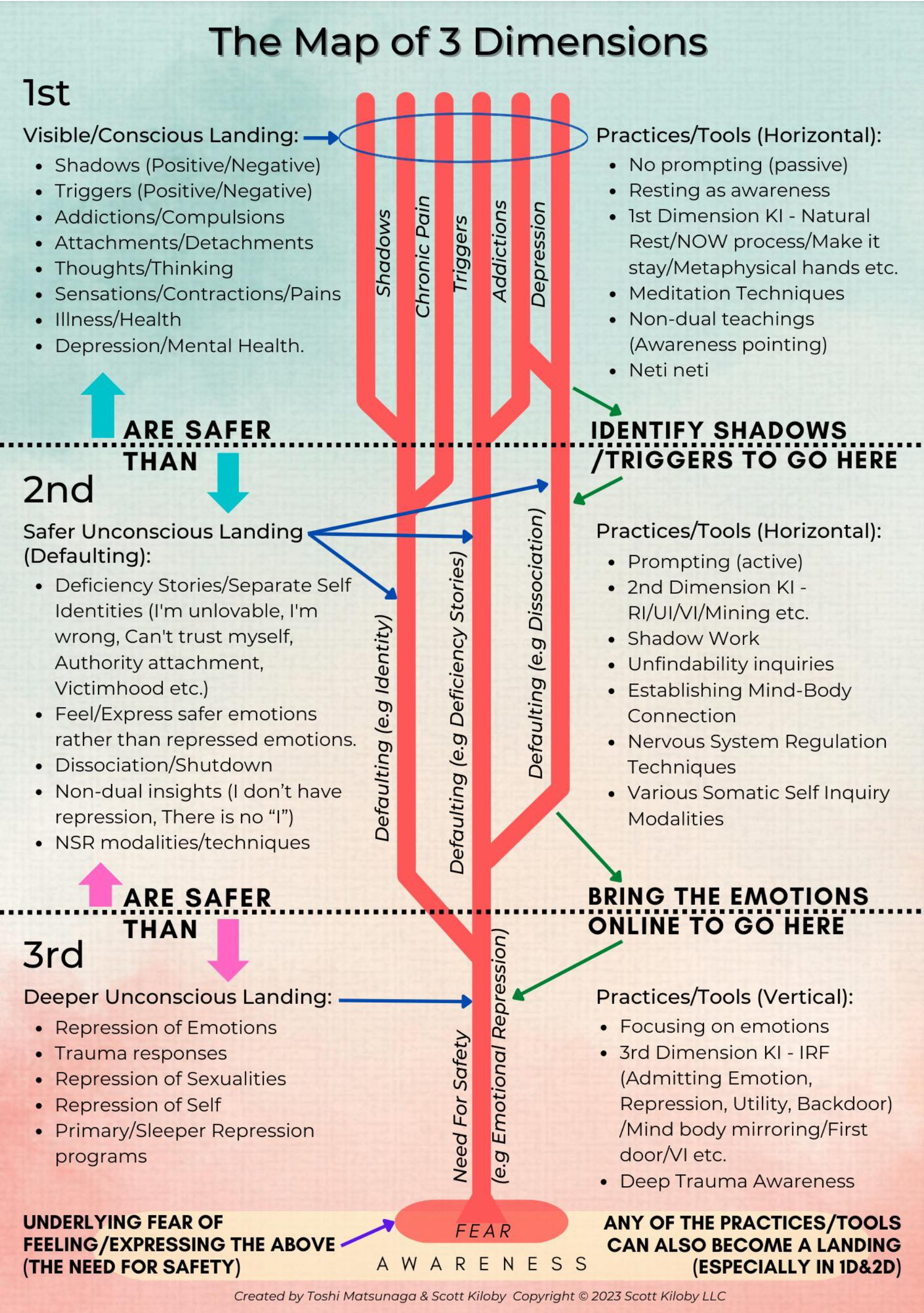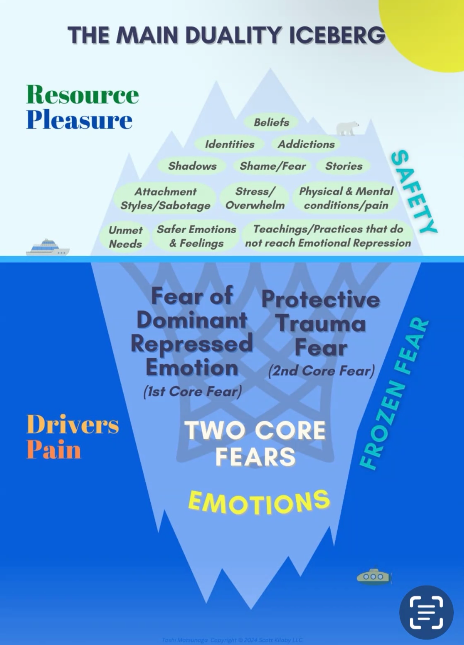
- inquiries
- i can think a say what i want (for anger repression)
- i can acomplish this

courses
This video walks you through the Safety Net — a practical somatic method to meet and work with your deepest emotional repression.
- Safety Net - Free Course from Scott Kiloby - YouTube
- What to Do After the Video
- Practice the tool daily for 2–3 minutes, several times per day.
- Focus only on one persistent pattern and one dominant emotion.
- Check the two markers (for a written explanation, see below, or click here)
- Make it a habit — subtle changes = deep healing.
- Join the Sabotage Workshop, a 90 minute workshop that demonstrates how our repression sabotages our life, relationships, & spiritual development.
The dominant repression is the emotion you cant feel .
reverse inquiry : the ripples , response in the body shows the truth .
revve up
rapid fire
first core fear
multiple core fears : sadness - anger - fear - etc.
the safety net : start with a persistent conscious pattern .
Inquiries :
- what do you get out of your pattern ? What emotional need is met ? Just listen to the body.
- Bring up the pattern , and say opposite what your need out of it is, you will feel resistance.
- if you couldn’t (pattern) what’s the opposite of that ? Then repeat that the opposite does not meet the need. And rapid fire saying it. Results :
Should be subtle to keep feeling safe .
The first marker is : feeling safe enough to continue. ( shouldn’t feel panic , anxious , dysregulated ).
2nd marker : the dissolving of the actual sense in the body , aim to small releases of energy and not too big to overwhelm the nervous system.
The Two Markers
It's important to "keep your eye on the ball," which means focusing on the two markers throughout your KI practice:
- The First Marker: Nervous System Regulation – When you finish the rapid-fire inquiry in your repression work, you should feel at least somewhat more regulated, grounded, or present. You don't need to seek out an intense spiritual experience; subtle feelings of being grounded or less agitated are enough. If KI makes you feel more anxious or agitated, it's important to stop and consult your mentor.
- The Second Marker: Transmuting Repression – As you rest as awareness, pay attention to any body contractions or sensations you feel. Notice details like their shape, size, density, and intensity. After completing an inquiry cycle, observe if these sensations have shifted or lightened in any way. Even small, subtle changes indicate transmutation. This process shows that your skill level is effective, and continuing with this practice will gradually clear repression.
- It's essential to maintain both a daily stand-alone practice (ideally at least five minutes or more) and an applied practice whenever suffering arises during your day. Always ensure you're seeing both markers in your inquiry work. While you don’t need to be perfect—moments of resistance, distraction, or even avoidance are normal—aim to observe the two markers most of the time. If you find that you’re consistently missing one or both markers, stop your practice and consult your mentor.
- In July 2024, the two markers became an official part of KI practice. If you aren’t seeing both markers during repression inquiry, you aren’t truly practicing KI. Instead, you may be stirring up repression unskillfully, potentially leading to dysregulation. This can create resistance toward KI, pulling you away from the process. The key to effective KI practice is to consistently check in with your body and make sure both markers are present. This ensures that your practice remains both safe and effective.
- KI repression inquiry targets emotional repression directly through a consistent, daily practice. Over time, this clears repression, but it's essential to be patient, as our system produces resistance to protect us from buried emotions. This resistance manifests as creating a sense of time and obstacles, often to maintain a sense of safety. Therefore, patience is crucial in this process, as it helps you persist through the natural resistance that arises when working with repression.
- Many people have successfully used KI by following these markers consistently throughout all phases of the KI path. To gain a full understanding of the journey, it’s recommended that you read up on the three phases of the KI path, as this will help you see how the two markers are crucial to the entire process.
Protocoll
What to Rapid Fire
Entry Point (Above the Water / Outside the Net) This is the surface program or complaint that’s showing up in their daily life, such as:
- I’m in pain
- They don’t hear me
- I don’t want to do KI
This is always a single entry point per practice. The chatbot helps the person pick one and stick with it per session. They start with a reverse inquiry like “I’m not in pain” and rev it up by stating it 3–5 times. Then they shift to rapid-fire the actual entry point, e.g.: I’m in pain. I’m in pain. I’m in pain. I’m in pain. I’m in pain.
This is the first rapid-fire and it’s outside the net. Acknowledgment of the Repressed Emotion (Inside the Net) Next, they drop into the net and begin with an acknowledgment of the repressed emotion:
- I’m angry. I’m angry. I’m angry. (For anger repression)
- I’m sad. I’m sad. I’m sad. (For sadness repression)
- I’m hurt. I’m hurt. I’m hurt. (For hurt repression)
This rapid-fire helps bring the body into connection with the dominant emotion and begins dissolving the frozen fear and avoidance around it.
3 Repression Command (Final Rapid Fire in the Net) This is the classic repression command tied to the dominant emotion:
- I can’t express the anger.
- I have to hold the anger back.
- I can’t cry.
- I can’t show hurt.
- I can’t be vulnerable.
This is often the most powerful part of the net and brings the greatest benefit. The chatbot should encourage people to stay here, especially if it continues producing the two markers.